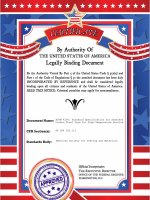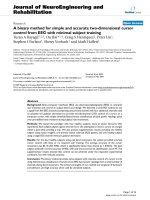ASTM D482 Standard Test Method for Ash from Petroleum Products
Bạn đang xem bản rút gọn của tài liệu. Xem và tải ngay bản đầy đủ của tài liệu tại đây (96.52 KB, 4 trang )
Designation: D482 − 13
Designation: 4/96
Standard Test Method for
Ash from Petroleum Products
1
This standard is issued under the fixed designation D482; the number immediately following the designation indicates the year of
original adoption or, in the case of revision, the year of last revision. A number in parentheses indicates the year of last reapproval. A
superscript epsilon (´) indicates an editorial change since the last revision or reapproval.
This standard has been approved for use by agencies of the Department of Defense.
1. Scope*
1.1 This test method covers the determination of ash in the
range 0.001–0.180 mass %, from distillate and residual fuels,
gas turbine fuels, crude oils, lubricating oils, waxes, and other
petroleum products, in which any ash-forming materials pres-
ent are normally considered to be undesirable impurities or
contaminants (
Note 1). The test method is limited to petroleum
products which are free from added ash-forming additives,
including certain phosphorus compounds (
Note 2).
NOTE 1—In certain types of samples, all of the ash-forming metals are
not retained quantitatively in the ash. This is particularly true of distillate
oils, which require a special ash procedure in order to retain metals
quantitatively.
N
OTE 2—This test method is not intended for the analysis of unused
lubricating oils containing additives; for such samples use Test Method
D874. Neither is it intended for the analysis of lubricating oils containing
lead nor for used engine crankcase oils.
1.2 The values stated in SI units are to be regarded as the
standard. The values given in parentheses are for information
only. The preferred expression of the property is mass %.
1.3 This standard does not purport to address all of the
safety concerns, if any, associated with its use. It is the
responsibility of the user of this standard to establish appro-
priate safety and health practices and determine the applica-
bility of regulatory limitations prior to use.
2. Referenced Documents
2.1 ASTM Standards:
2
D874 Test Method for Sulfated Ash from Lubricating Oils
and Additives
D4057 Practice for Manual Sampling of Petroleum and
Petroleum Products
D4177 Practice for Automatic Sampling of Petroleum and
Petroleum Products
D4928 Test Method for Water in Crude Oils by Coulometric
Karl Fischer Titration
D6299 Practice for Applying Statistical Quality Assurance
and Control Charting Techniques to Evaluate Analytical
Measurement System Performance
D6792 Practice for Quality System in Petroleum Products
and Lubricants Testing Laboratories
3. Summary of Test Method
3.1 The sample contained in a suitable vessel is ignited and
allowed to burn until only ash and carbon remain. The
carbonaceous residue is reduced to an ash by heating in a
muffle furnace at 775°C, cooled and weighed.
4. Significance and Use
4.1 Knowledge of the amount of ash-forming material
present in a product can provide information as to whether or
not the product is suitable for use in a given application. Ash
can result from oil or water-soluble metallic compounds or
from extraneous solids such as dirt and rust.
5. Apparatus
5.1 Evaporating Dish or Crucible , made of platinum, silica,
or porcelain, of a capacity of 50 to 150 mL.
NOTE 3—Alumina vessels may be used where appropriate. The use of
vessels that are not made of platinum may contaminate the ash.
5.2 Electric Muffle Furnace, capable of maintaining a tem-
perature of 775 6 25°C and preferably having suitable
apertures at the front and rear so as to allow a slow natural
draught of air to pass through or a programmable furnace
controlling both temperature and air flow is suitable.
5.3 Meeker Gas Burner, or equivalent.
5.4 Mechanical Shaker.
5.5 Filter Paper.
1
This test method is under the jurisdiction of ASTM Committee D02 on
Petroleum Products, Liquid Fuels, and Lubricants and is the direct responsibility of
Subcommittee
D02.03 on Elemental Analysis.
Current edition approved June 15, 2013. Published August 2013. Originally
approved in 1938. Last previous edition approved in 2012 as D482 – 12. DOI:
10.1520/D0482-13.
In the IP, this test method is under the jurisdiction of the Standardization
Committee. This test method was adopted as a joint ASTM-IP standard in 1965.
2
For referenced ASTM standards, visit the ASTM website, www.astm.org, or
contact ASTM Customer Service at For Annual Book of ASTM
Standards volume information, refer to the standard’s Document Summary page on
the ASTM website.
*A Summary of Changes section appears at the end of this standard
Copyright © ASTM International, 100 Barr Harbor Drive, PO Box C700, West Conshohocken, PA 19428-2959. United States
1
Copyright by ASTM Int'l (all rights reserved); Sat Oct 19 11:46:58 EDT 2013
Downloaded/printed by
Pontifcia Universidade Catlica do Rio Grande do Sul pursuant to License Agreement. No further reproductions authorized.
6. Reagents
6.1 Propan-2-ol— (Warning—Flammable, can be explo-
sive when evaporated to or near dryness.)
6.2 Toluene—(Warning—Flammable, toxic.)
6.3 Quality Control (QC) Samples , preferably are portions
of one or more liquid petroleum materials that are stable and
representative of the samples of interest. These QC samples
can be used to check the validity of the testing process as
described in Section
11.
7. Sampling
7.1 Obtain samples in accordance with the instructions in
Practice
D4057 or D4177. Before transferring the portion of
the sample to be ashed to the evaporating dish or crucible, take
particular care to ensure that the portion taken is truly
representative of the larger portion. Vigorous shaking can be
necessary.
8. Procedure
8.1 Heat the evaporating dish or crucible that is to be used
for the test at 700 to 800°C for a minimum of 10 min. Cool to
room temperature in a suitable container, and weigh to the
nearest 0.1 mg.
NOTE 4—The container in which the dish or crucible is cooled can be
a desiccator not containing a desiccating agent. In addition, all weighings
of the crucibles should be performed as soon as the crucibles have cooled.
If it should be necessary that the crucibles remain in the desiccator for a
longer period, then all subsequent weighings should be made after
allowing the crucibles and contents to remain in the desiccator for the
same length of time.
8.2 When the sample is sufficiently mobile, mix thoroughly
before weighing. The mixing is necessary to distribute catalyst
fines and other particulate material throughout the sample.
Satisfactory mixing can usually be achieved by 10 min of
manual shaking or 10 min using a mechanical shaker. Examine
the sample for homogeneity before proceeding with
8.3.
Continue mixing the sample if it is not homogeneous.
8.2.1 When it is evident that the sample is not homogenized
after repeated mixings, or there is a reasonable doubt, a
non-aerating, high-speed shear mixer can be used. Such a
device is described in Annex A1 of Test Methods
D4928.
8.2.2 When the sample cannot be satisfactorily
homogenized, reject the sample and acquire a new sample.
8.2.3 When the sample is viscous or solid at room
temperature, heat the container carefully until the sample is
entirely liquid and mix carefully. An oven at an appropriate
temperature can be used.
8.2.4 The sample can contain water. After heating in an
oven, the water can boil causing splattering or foaming. The
operator shall proceed cautiously with the heating step, wear-
ing appropriate personnel protective equipment, such as safety
goggles and gloves. Mixing this type of sample shall be done
carefully. Stirring, rather than shaking, is an option.
8.3 The quantity of test specimen taken for testing will
depend upon the ash content expected in the sample. Refer to
Table 1. The weighing procedure will also depend upon
whether the sample requires heating or not, and whether more
than one portion has to be weighed.
8.4 Using a top-loading balance, weigh into the dish or
crucible sufficient test specimen to the nearest 0.1 g to yield no
more than 20 mg of ash. Determine the mass of the test
specimen used in the analysis at ambient temperature. One way
to do this is to take the difference between the initial and final
masses of the sample container weighed at ambient tempera-
tures. If one weighing is sufficient, as determined from
Table 1,
or experience, proceed with steps 8.6 – 8.11.
8.5 If more than one addition of test specimen is required,
proceed only through
8.6 (noting 8.6.1 and 8.7) and allow the
dish or crucible to cool to ambient temperature before adding
more sample as outlined in
8.4. Proceed with steps 8.6 – 8.11.
8.6 Carefully heat the dish or crucible with a Meeker burner
or equivalent until the contents can be ignited by the flame.
Maintain the dish or crucible at such a temperature that the
sample continues to burn at a uniform and moderate rate
leaving only a carbonaceous residue when the burning ceases.
A hot plate can be used at this stage.
8.6.1 The test sample may contain water that can cause
spattering. The operator shall heat the test portion cautiously
while wearing appropriate personnel protective equipment,
such as safety goggles and gloves. If spattering is very severe,
so that material escapes the confines of the dish or the crucible,
discard the test portion. If the first test portion is discarded, add
2 6 1 mL of propan-2-ol (Warning—Flammable) to a second
test portion while stirring with a glass rod and warming the test
portion gently to liquefy if it is solid or near solid. Proceed as
described in
8.6. If this is unsuccessful, repeat on a third test
portion using a 10 6 1 mL mixture of 50 6 5 % by volume
toluene (Warning— Flammable. Vapor harmful) and 50 6 5
% by volume of propan-2-ol. In either case, any test specimen
that adheres to the glass rod can be returned to the dish using
a strip of ashless filter paper. Continue burning as outlined in
8.6.
8.7 Vigilance by the operator is mandatory; burning samples
shall never be left unattended.
8.8 Some test specimens will require extra heating after the
burning has ceased, particularly heavy samples such as marine
fuels which form crusts over the unburned material. The crust
can be broken with a glass rod. Any crust that adheres to the
glass rod can be returned to the dish using a strip of ashless
filter paper. Burn the remaining test specimen.
8.9 The heavier material tends to foam, therefore the opera-
tor shall exercise considerable care. Overheating shall be
avoided so that neither the test specimen nor the dish are heated
to a red hot appearance, as this can result in loss of ash.
TABLE 1 Test Specimen Mass versus Ash
Expected Ash, mass %
Test Specimen,
mass, g
Ash Mass, mg
0.18 11 20
0.10 20 20
0.05 40 20
0.04 50 20
0.02 100 20
0.01 100 10
0.001 100 1
D482 − 13
2
Copyright by ASTM Int'l (all rights reserved); Sat Oct 19 11:46:58 EDT 2013
Downloaded/printed by
Pontifcia Universidade Catlica do Rio Grande do Sul pursuant to License Agreement. No further reproductions authorized.
Likewise, the flame shall never be higher than the rim of the
dish to avoid superheating the crust, thereby producing sparks
that can result in considerable loss of ash.
8.10 Heat the residue in the muffle furnace at 775 6 25°C
until all carbonaceous material has disappeared. Cool the dish
to room temperature in a suitable container (
Note 4), and weigh
to the nearest 0.1 mg.
8.11 Reheat the dish at 775 6 25 °C for at least 20 min, cool
in a suitable container (
Note 4), and reweigh. Repeat the
heating, cooling, and weighing process until consecutive
weighings differ by not more than 0.5 mg.
9. Calculation
9.1 Calculate the mass of the ash as a percentage of the
original samples as follows:
Ash, mass % 5
~
w/W
!
3 100 (1)
where:
w = mass of ash, g, and
W = mass of sample, g.
10. Report
10.1 Report the results as follows:
Test Specimen Mass Report
9.00 to 39.99 g 3 decimal places
40.00 or more g 3 to 4 decimal places
10.2 Record the value reported as ash in accordance with
Test Method D482, stating the mass of the sample taken.
11. Quality Control:
11.1 Confirm the performance of the instrument or the test
procedure by analyzing a QC sample (see
6.3).
11.1.1 When QC/Quality Assurance (QA) protocols are
already established in the testing facility, these may be used to
confirm the reliability of the test result.
11.1.2 When there is no QC/QA protocol established in the
testing facility,
Appendix X1 can be used as the QC/QA
system.
12. Precision and Bias
3
12.1 The precision of this test method as obtained by
statistical examination of interlaboratory test results is as
follows:
12.1.1 Repeatability—The difference between successive
tests results, obtained by the same operator with the same
apparatus under constant operating conditions on identical test
material would, in the long run, in the normal and correct
operation of the test method, exceed the following values only
in one case in twenty:
Ash, mass % Repeatability
0.001 to 0.079 0.003
0.080 to 0.180 0.007
12.1.2 Reproducibility—The difference between two single
and independent results obtained by different operators in
different laboratories on identical test material would, in the
long run, in the normal and correct operation of the test
method, exceed the following values only in one case in
twenty:
Ash, mass % Reproducibility
0.001 to 0.079 0.005
0.080 to 0.180 0.024
12.2 Bias—The bias of this test method cannot be deter-
mined since an appropriate standard reference material con-
taining a known level of ash in liquid petroleum hydrocarbon
is not available.
13. Keywords
13.1 ash; crude oils; distillate oils; fuel oils; lubricating oils
APPENDIX
(Nonmandatory Information)
X1. QUALITY CONTROL
X1.1 Confirm the performance of the instrument or the test
procedure by analyzing a QC sample.
X1.2 Prior to monitoring the measurement process, the user
of the test method needs to determine the average value and
control limits of the QC sample (see Practices
D6299 and
D6792 and MNL 7).
4
X1.3 Record the QC results and analyze by control charts or
other statistically equivalent techniques, to ascertain the statis-
tical control status of the total testing process (see Practices
D6299 and D6792 and MNL 7). Any out-of-control data should
trigger investigation for root cause(s).
X1.4 In the absence of explicit requirements given in the
test method, the frequency of QC testing is dependent on the
criticality of the quality being measured, the demonstrated
stability of the testing process, and customer requirements.
Generally, a QC sample is analyzed each testing day with
routine samples. The QC frequency should be increased if a
large number of samples are routinely analyzed. However,
when it is demonstrated that the testing is under statistical
control, the QC testing frequency may be reduced. The QC
sample precision should be checked against the ASTM method
precision to ensure data quality.
X1.5 It is recommended that, if possible, the type of QC
sample that is regularly tested be representative of the material
3
No ASTM Research Report is available for this standard.
4
ASTM MNL 7, Manual on Presentation of Data Control Chart Analysis,6
th
ed., ASTM International, W. Conshohocken, PA.
D482 − 13
3
Copyright by ASTM Int'l (all rights reserved); Sat Oct 19 11:46:58 EDT 2013
Downloaded/printed by
Pontifcia Universidade Catlica do Rio Grande do Sul pursuant to License Agreement. No further reproductions authorized.
routinely analyzed. An ample supply of QC sample material
should be available for the intended period of use, and must be
homogenous and stable under the anticipated storage condi-
tions. See Practice D6299 and D6792 and MNL 7 for further
guidance on QC and Control Charting techniques.
SUMMARY OF CHANGES
Subcommittee D02.03 has identified the location of selected changes to this standard since the last issue
(D482 – 12) that may impact the use of this standard.
(1) Added information in subsections
5.1, 5.2, and 5.5 in
Apparatus section to keep consistent with equivalent test
method IP 4.
ASTM International takes no position respecting the validity of any patent rights asserted in connection with any item mentioned
in this standard. Users of this standard are expressly advised that determination of the validity of any such patent rights, and the risk
of infringement of such rights, are entirely their own responsibility.
This standard is subject to revision at any time by the responsible technical committee and must be reviewed every five years and
if not revised, either reapproved or withdrawn. Your comments are invited either for revision of this standard or for additional standards
and should be addressed to ASTM International Headquarters. Your comments will receive careful consideration at a meeting of the
responsible technical committee, which you may attend. If you feel that your comments have not received a fair hearing you should
make your views known to the ASTM Committee on Standards, at the address shown below.
This standard is copyrighted by ASTM International, 100 Barr Harbor Drive, PO Box C700, West Conshohocken, PA 19428-2959,
United States. Individual reprints (single or multiple copies) of this standard may be obtained by contacting ASTM at the above
address or at 610-832-9585 (phone), 610-832-9555 (fax), or (e-mail); or through the ASTM website
(www.astm.org). Permission rights to photocopy the standard may also be secured from the ASTM website (www.astm.org/
COPYRIGHT/).
D482 − 13
4
Copyright by ASTM Int'l (all rights reserved); Sat Oct 19 11:46:58 EDT 2013
Downloaded/printed by
Pontifcia Universidade Catlica do Rio Grande do Sul pursuant to License Agreement. No further reproductions authorized.
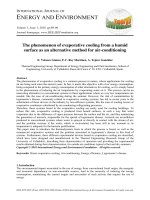
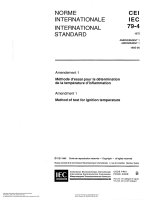
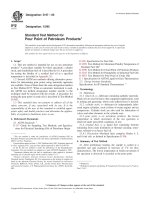
![Standard Test Method for Compressive Strength of Hydraulic Cement Mortars (Using 2-in. or [50-mm] Cube Specimens)](https://media.store123doc.com/images/document/14/rc/yi/medium_yil1395845738.jpg)
